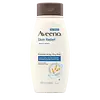What's inside
What's inside
 Key Ingredients
Key Ingredients

 Benefits
Benefits

 Concerns
Concerns

 Ingredients Side-by-side
Ingredients Side-by-side

Water
Skin ConditioningSodium Trideceth Sulfate
CleansingPetrolatum
EmollientSodium Chloride
MaskingCocamidopropyl Betaine
CleansingTrideceth-3
EmulsifyingNiacinamide
SmoothingAvena Sativa Kernel Extract
AbrasiveSodium Benzoate
MaskingSodium Salicylate
PreservativeSodium Citrate
BufferingGuar Hydroxypropyltrimonium Chloride
Skin ConditioningXanthan Gum
EmulsifyingCitric Acid
BufferingSodium Hydroxide
BufferingGlyceryl Oleate
EmollientDisodium EDTA
Acrylates/C10-30 Alkyl Acrylate Crosspolymer
Emulsion StabilisingWater, Sodium Trideceth Sulfate, Petrolatum, Sodium Chloride, Cocamidopropyl Betaine, Trideceth-3, Niacinamide, Avena Sativa Kernel Extract, Sodium Benzoate, Sodium Salicylate, Sodium Citrate, Guar Hydroxypropyltrimonium Chloride, Xanthan Gum, Citric Acid, Sodium Hydroxide, Glyceryl Oleate, Disodium EDTA, Acrylates/C10-30 Alkyl Acrylate Crosspolymer
Water
Skin ConditioningGlycerin
HumectantCocamidopropyl Betaine
CleansingPEG-80 Sorbitan Laurate
Sodium Cocoyl Isethionate
CleansingAvena Sativa Kernel Flour
AbrasiveAvena Sativa Kernel Extract
AbrasiveAvena Sativa Kernel Oil
Skin ConditioningAcrylates/C10-30 Alkyl Acrylate Crosspolymer
Emulsion StabilisingDipropylene Glycol
HumectantEthylene Brassylate
Masking2,6-Dimethyl-7-Octen-2-Ol
MaskingPelargonium Graveolens Flower Oil
MaskingCommiphora Myrrha Oil
MaskingCaprylyl Glycol
EmollientSodium Benzoate
MaskingPotassium Sorbate
PreservativeSodium Hydroxide
BufferingWater, Glycerin, Cocamidopropyl Betaine, PEG-80 Sorbitan Laurate, Sodium Cocoyl Isethionate, Avena Sativa Kernel Flour, Avena Sativa Kernel Extract, Avena Sativa Kernel Oil, Acrylates/C10-30 Alkyl Acrylate Crosspolymer, Dipropylene Glycol, Ethylene Brassylate, 2,6-Dimethyl-7-Octen-2-Ol, Pelargonium Graveolens Flower Oil, Commiphora Myrrha Oil, Caprylyl Glycol, Sodium Benzoate, Potassium Sorbate, Sodium Hydroxide
 Reviews
Reviews

Ingredients Explained
These ingredients are found in both products.
Ingredients higher up in an ingredient list are typically present in a larger amount.
Acrylates/C10-30 Alkyl Acrylate Crosspolymer is a synthetic polymer. It is used to thicken and improve the texture of products. Due to its properties, it can prevent water and oil ingredients from separating.
Avena Sativa Kernel Extract is is derived from colloidal oatmeal. Besides being a healthy breakfast, oats have many benefits in skincare too.
This ingredient helps sooth, hydrate, and protect the skin. The starches in colloidal oatmeal are able to bind water, keeping the skin hydrated.
The cellulose and fiber in colloidal oatmeal help reduce inflammation. This can also help the skin feel softer.
Colloidal Oatmeal is also an antioxidant. Antioxidants protect our skin from free-radical damage.
Oatmeal also contains beneficial compounds:
This ingredient is created by mixing grounded oatmeal and a liquid base.
Learn more about Avena Sativa Kernel ExtractCocamidopropyl Betaine is a fatty acid created by mixing similar compounds in coconut oil and dimethylaminopropylamine, a compound with two amino groups.
This ingredient is a surfactant and cleanser. It helps gather the dirt, pollutants, and other impurities in your skin to be washed away. It also helps thicken a product and make the texture more creamy.
Being created from coconut oil means Cocamidopropyl Betaine is hydrating for the skin.
While Cocamidopropyl Betaine was believed to be an allergen, a study from 2012 disproved this. It found two compounds in unpure Cocamidopropyl Betaine to be the irritants: aminoamide and 3-dimethylaminopropylamine. High-grade and pure Cocamidopropyl Betaine did not induce allergic reactions during this study.
Learn more about Cocamidopropyl BetaineSodium Benzoate is a preservative. It's used in both cosmetic and food products to inhibit the growth of mold and bacteria. It is typically produced synthetically.
Both the US FDA and EU Health Committee have approved the use of sodium benzoate. In the US, levels of 0.1% (of the total product) are allowed.
Sodium benzoate works as a preservative by inhibiting the growth of bacteria inside of cells. It prevents the cell from fermenting a type of sugar using an enzyme called phosphofructokinase.
It is the salt of benzoic acid. Foods containing sodium benzoate include soda, salad dressings, condiments, fruit juices, wines, and snack foods.
Studies for using ascorbic acid and sodium benzoate in cosmetics are lacking, especially in skincare routines with multiple steps.
We always recommend speaking with a professional, such as a dermatologist, if you have any concerns.
Learn more about Sodium BenzoateSodium Hydroxide is also known as lye or caustic soda. It is used to adjust the pH of products; many ingredients require a specific pH to be effective.
In small amounts, sodium hydroxide is considered safe to use. However, large amounts may cause chemical burns due to its high alkaline.
Your skin has a natural pH and acid mantle. This acid mantle helps prevent harmful bacteria from breaking through. The acid mantle also helps keep your skin hydrated.
"Alkaline" refers to a high pH level. A low pH level would be considered acidic.
Learn more about Sodium HydroxideWater. It's the most common cosmetic ingredient of all. You'll usually see it at the top of ingredient lists, meaning that it makes up the largest part of the product.
So why is it so popular? Water most often acts as a solvent - this means that it helps dissolve other ingredients into the formulation.
You'll also recognize water as that liquid we all need to stay alive. If you see this, drink a glass of water. Stay hydrated!
Learn more about Water